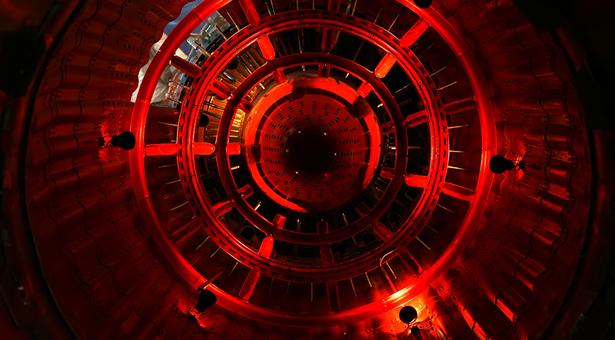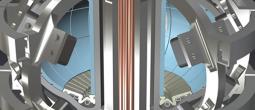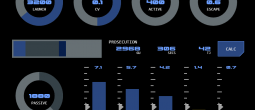

MIE impulse engines

The vessel's main propulsion is provided by Magnetoplasma Impulse Engines (MIE's), which utilise terrestrially-developed magnetoplasma impulse technology.
These engines are the primary source of propulsion for the vessel and generate thrust to provide the propulsion from the creation and acceleration of high-temperature plasma. As such, there are similarities to plasma management principles in the vessel’s fusion reactor, except in this case the plasma is designed to escape containment as quickly as possible.
Operation
MIE engines generate plasma which is directed through a series of powerful magnetic containment fields. The plasma is maintained under pressure to increase its energy level. To generate thrust, plasma is released via a contricted opening in the containment field, with the plasma's energy converted to thrust as it exits at high speed. Escaping plasma is further accelerated by carefuly sequenced magnetic fields generated with in the output nozzle inner surafce. This significantly increases the thrust produced by the plasma to levels necessary for maneuvering a large vessel and to engage superluminal drive systems.
An advantage of MIE engines is their ability to deliver variable specific impulse. High specific impulse provides high thrust/high fuel consumption for acceleration, while low specific impulse provides low-thrust/low fuel consumption for maintaining speed and maneuvering.
Operating Stages
MIE engines have four operational stages:
Plasma Generation
Fuel gas (hydrogen) is ionized using helicon RF antennas. This creates a relatively dense, cold plasma (60,000K) The resulting plasma is containable by a magnetic field, a requirement for managing the extreme temperatures generated by the next stage.
Plasma Excitement
The initial plasma is fed into a magnetic field designed as a mirror, to trap the low energy initial plasma so that it can be superheated (excited). Plasma is excited using an ion cyclotron resonance heating (ICRH) process, which increases the kinetic energy of the energy of the plasma to the point that it's controlled escape from containment generates an opposing force - thrust.
The magnetic containment field is configured to produce a gradeient along the length of the containment chamber, steadily increasing pressure on the plasma to ensure that continued progress through the chamber requires higher energy. The end of the containment field is constricted to ensure that only plasma with high enough energy is capable of escaping. The constriction is periodically lowered temporarily as part of a regular cycle to allow a rush of plasma to escape at high velocity.
Plasma Acceleration
The excited plasma is directed to a magnetic field with an open-ended gradient that creates a magnetic 'output nozzle' lined with powerful magnetic field generators. These generators create a series of constantly variable magnetic gradients arranged to create an impulse pattern that accelerates the plasma and significantly increases the kinetic energy available for conversion to thrust. At a point along the nozzle's magnetic field the field strength becomes weaker than the strength of the plasma's flow and the plasma detaches. it is at this point that thrust is generated.
Directional Control
As the plasma progresses through the acceleration stage, the magnetic field generators can be adjusted to make slight changes to the direction of the plasma flow out of the engine, enough to allow the vessel to be steered.
Reverse Thrust Diverters
An additional series of magnetic field generators can be used to alter the profile of the plasma acceleration and exhaust stage, diverting plasma towards forward-facing output vents. This allows the engines to apply forward thrust to slow and stop forward movement inertia.
The diversion process reduces the efficiency of the plasma acceleration phase, requiring more energy and/or time to apply the equivalent reverse thrust.
Construction
The engines produce strong magnetic fields which would seriously interfere with other ships systems and cause adverse interactions with planetary magnetospheres.
To counteract this problem, each engine is made up of a pair of ''thruster units'' (each pod consisting of a complete MIE system), with the magnetic fields of each pod oriented as opposite magnetic dipoles.
Performance & Output
Each thruster unit within an MIE engine is rated at 500KW, used to generate RF in the plasma generation and excitation stages. These stages operate approximately 90% efficiency, with approximately 50KW lost as heat per unit.
The level of thrust this provides enables the vessel to reach 0.01c (the minimum safe velocity to maintain a stable warp field) in approximately 15 minutes.








